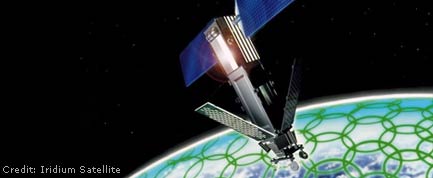U.S. Satellite Destroyed in Space Collision

This story was updated at 7:28 p.m. EST.
WASHINGTON — Iridium Satellite LLC confirmed today that one of its satellites was destroyed Tuesday in an unprecedented collision with a spent Russian satellite and that the incident could result in limited disruptions of service.
According to an e-mail alert issued by NASA today, Russia's Cosmos 2251 satellite slammed into the Iridium craft at 11:55 a.m. EST (0455 GMT) over Siberia at an altitude of 490 miles (790 km). The incident was observed by the U.S. Defense Department's Space Surveillance Network, which later was tracking two large clouds of debris.
"This is the first time we've ever had two intact spacecraft accidentally run into each other," said Nicholas Johnson, chief scientist of NASA's Orbital Debris Program Office at the Johnson Space Center in Houston. "It was a bad day for both of them."
The collision appears to be the worst space debris event since China intentionally destroyed one of its aging weather satellites during a 2007 anti-satellite test, Johnson told SPACE.com. That 2007 event has since left about 2,500 pieces of debris in Earth orbit, but more time is needed to pin down the extent of Tuesday's satellite collision, he added.
"We're tracking more than 500 pieces of debris which pose an additional risk to satellites," said U.S. Navy Lt. Charlie Drey, a spokesperson for the U.S. Strategic Command which oversees the U.S. Space Surveillance Network.
In a prepared statement, the Bethesda, Md.-based Iridium characterized the incident as a "very low probability event" and said it was taking immediate action to minimize any loss of service. Iridium, which operates a constellation of 66 low Earth orbiting satellites providing mobile voice and data communications globally, said its system remains healthy and that it would implement a "network solution" by Friday.
Get the Space.com Newsletter
Breaking space news, the latest updates on rocket launches, skywatching events and more!
"Within the next 30 days, Iridium expects to move one of its in-orbit spare satellites into the network constellation to permanently replace the lost satellite," the statement said.
The 1,234-pound (560-kg) Iridium 33 satellite involved in the collision was launched in 1997; the 1,984-pound (900-kg) Russian satellite was launched in 1993 and presumed non-operational. It did not have a maneuvering system, NASA said.
Iridium's spacecraft circle the Earth along a near-polar orbit once every 100 minutes and fly at a speed of about 16,832 mph (27,088 kph), the company states on its Web site.
An unprecedented crash
Johnson said outdated spacecraft, rocket stages and other components break apart in space every year, but there have only been three relatively minor collisions between such objects in the last 20 years. Never before have two intact satellites crashed into one another by accident, he added.
The debris created in Tuesday's collision is being tracked to assess its risk of damaging other satellites and the International Space Station, which is currently home to two American astronauts and one Russian cosmonaut.
The space station flies at an altitude of about 220 miles (354 km), well below the impact point between the Russian and U.S. satellites 490 miles (790 km) up. Johnson said that only a very minor portion of debris from the two clouds is expected to descend across the space station's orbital path.
"We believe that the increased risk above the normal every day background risk is very, very small," Johnson said
NASA's orbital debris experts are also assessing the threat to other spacecraft. The agency's Earth Observing System satellites, which orbit at 438 miles (705 km), "are of highest interest for immediate consideration," NASA said in its e-mail alert, a copy of which was forwarded to Space News, a sister publication to SPACE.com.
Drey told SPACE.com that the first hint of the collision came when Iridium officials contacted a U.S. Strategic Command support office to report that they had lost contact with one of their satellites.
"Shortly after, our space surveillance center reported that they had observed multiple new objects in low orbit," Drey said. The U.S. Space Surveillance Network continuously tracks more than 18,000 separate man-made objects and debris at any given time, he added.
Tuesday's collision is the latest in a series of satellite woes in recent weeks.
Last month, the nascent Eutelsat W2M telecommunications satellite failed in orbit just five weeks after it launched into space. Another communications satellite, ASTRA 5A owned by SES Luxemburg, also failed and was adrift in orbit. The loss forced its operators to warn the owners of neighboring satellites to be prepared for the remote possibility of having to maneuver their spacecraft to avoid a collision with Astra 5A.
NASA's Orbital Debris Program Office also released an update last month on Russia's Soviet-era satellite Cosmos 1818 stating that the spacecraft appeared to spew a cloud of debris on July 4, 2008 that may be the result of leaking reactor coolant from a debris strike or fragmentation.
SPACE.com Senior Editor Tariq Malik contributed to this story from New York City.
Join our Space Forums to keep talking space on the latest missions, night sky and more! And if you have a news tip, correction or comment, let us know at: community@space.com.
Becky Ianotta is a former SpaceNews reporter covering space industry and policy news from 2008 to 2009. Becky earned a bachelor's degree in English/Journalism from the University of Miami. She spent five years as an editor with the Key West Citizen in Florida before joining the SpaceNews team. She later wrote for Air Force Times before taking her current position as communication director for Mother's Against Drunk Driving.









